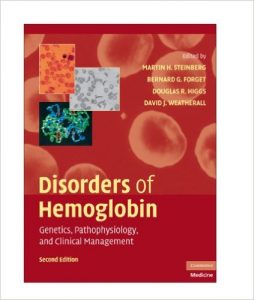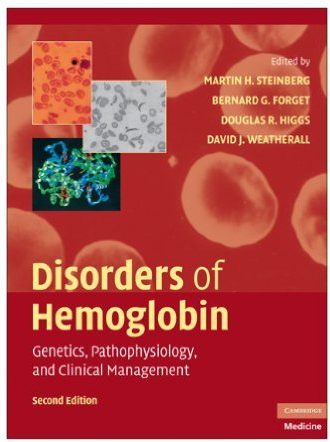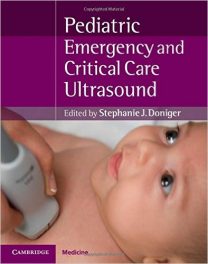 Editors: Martin H. Steinberg, MD; Bernard G. Forget, MD; Douglas R. Higgs, MD; and David J. Weatherall, MD
Editors: Martin H. Steinberg, MD; Bernard G. Forget, MD; Douglas R. Higgs, MD; and David J. Weatherall, MD
Publisher: Cambridge University Press – 826 pages
Book Review by: Nano Khilnani
We all know that sickle cell anemia causes fatigue. In addition, you may or may not know that it also delays growth in infants and children, including delayed puberty in teenagers. It leads to infections that can damage your spleen, the very organ that fights infection. This disease also results in pain in the abdomen, bones, chest, and joints, and in swollen feet and hands. Some people with sickle cell anemia also experience vision problems.
Sickle cell anemia, referred to in short as SCA, is the subject of chapter 19, one of five chapters within Section Five entitled Sickle Cell Disease. In that chapter, authors Martin H. Steinberg, Kwaku Ohene-Frempong, and Matthew M. Heeney, write that sickle-shaped or crescent-shaped or partial-moon-shaped red cells were first described when they were found in 1910 in the United States in the blood of an anemic student from Grenada. It appears that no research was done after that discovery. Perhaps it was.
So it was not until almost four decades later that researchers took a closer look at this disease of the blood. The three authors write about this crucial development: “Sickle Hemoglobin (HbS) was identified in 1949 and the mechanism of inheritance of sickle cell anemia was established. A single amino-acid difference was found to distinguish the β globin chain from the normal one.”
This second edition provides an updated overview of the ‘hemoglobin story’ as the editors term it. Significant advances in this story, since the first edition was published in 2009, have occurred in biochemistry, clinical investigation, and genetics. Those advances are detailed in this second edition published in 2016.
Fifty people including the four editors named above, authored the 33 chapters of this large book of over 800 pages, focused on the disorders of hemoglobin. They are mainly from the United States and the United Kingdom, but also from Canada, Kenya, Thailand, and the Netherlands. They are all MDs and PhDs treating and / or teaching others, as well as doing research. They work in the challenging but rewarding fields of biochemistry, biology, endocrinology, genetics, genomics, hematology, laboratory medicine, neurology, oncology, pediatrics, physiology, physics, radiology, and surgery.
In order to provide you – the trainee or practitioner – an overview of what you will find in this authoritative, wide-ranging, and very large book, we list below the titles of its chapters and sections:
Introduction
- Section One: Molecular, Cellular, and Genetic Basis of Hemoglobin Disorders
- A Developmental Approach to Hematopoiesis
- Erythropoiesis
- The Normal Structure and Regulation of Human Globin Gene Clusters
- Nuclear Factors that Regulate Erythropoiesis
- Molecular and Cellular Basis of Hemoglobin Switching
- Structure and Function of Hemoglobin and Its Dysfunction in Sickle Cell Disease
- Hemoglobin of the Embryo, Fetus, and Adult
- Section Two: Pathophysiology of Hemoglobin and Its Disorders
- Rheology and Vascular Pathobiology in Sickle Cell Disease and Thalassemia
- The Erythrocite Membrane
- The Biology of Vascular Nitric Oxide
- Mechanisms/Clinical Complications of Hemolysis in Sickle Cell Disease, Thalassemia
- Animal Models of Hemoglobinopathies and Thalassemia
- Section Three: α Thalassemia
- The Molecular Basis of α Thalassemia
- The Pathophysiology and Clinical Features of α Thalassemia
- Unusual Types of α Thalassemia
- Section Four: The β Thalassemia
- The Molecular Basis of β Thalassemia, δβ Thalassemia, and Hereditary Persistence of Fetal Hemoglobin
- Clinical Aspects of β Thalassemia and Related Disorders
- Hemoglobin E Disorders
- Section Five: Sickle Cell Disease
- Clinical and Pathophysiological Aspects of Sickle Cell Anemia
- Sickle Cell Pain: Biology, Etiology, and Treatment
- Hemoglobin SC Disease and Hemoglobin C Disorders
- Sickle Cell Trail
- Other Sickle Hemoglobinopathies
- Section Six: Other Clinically Important Disorders of Hemoglobin
- Unstable Hemoglobins, Hemoglobins with Altered Oxygen Affinity, Hemoglobin M, and Other Variants of Clinical and Biological Interest
- Dyshemoglobinemias
- Section Seven: Special Topics in Hemoglobinopathies
- Population Genetics and Global Health Burden
- Genetic Modulation of Sickle Cell Disease and Thalassemia
- Laboratory Methods for Diagnosis and Evaluation of Hemoglobin Disorders
- Section Eight: New Approaches to the Treatment of Hemoglobinopathies and Thalassemia
- Transfusion and Iron Chelation Therapy in Thalassemia and Sickle Cell Disease
- Induction of Fetal Hemoglobin in Treatment of Sickle Cell Disease and β Thalassemia
- Novel Approaches to Treatment
- Stem Cell Transplantation
- Prospects for Gene Therapy of Sickle Cell Disease and Thalassemia
We take a closer look below at the contents of Section Five, entitled Sickle Cell Disease, and particularly, chapter 19 entitled Clinical and Pathophysiological Aspects of Sickle Cell Anemia, that we began to discuss earlier as we described the effects of sickle cell anemia upon people afflicted with it.
Sickle cell disease is essentially a constellation of similar but not identical disorders, all of which have at least 50 percent sickle Hemoglobin (HbS) in the blood. Laboratory diagnosis of the blood can detect the presence of, and quantify the amount of HbS in one’s blood. Dr. Steinberg writes about the diagnosis of SCA at the beginning of Section Five:
“The phenotype of sickle cell disease is caused by several common and some less common genotypes; homozygotes for the HbS gene are said to have sickle cell anemia; common compound heterozygous forms of disease include HbS disease and HbS-β thalassemia.”
The complications resulting from sickle cell disease can occur acutely, or they can be chronic, disabling, or cause premature death.
Before doing a content overview of this section and this chapter, here’s a quick view and short list of sickle cell anemia complications we found in a Wikipedia article:
- Acute papillary necrosis in the kidneys
- Avascular necrosis (aseptic bone necrosis) of the hip and other major joints
- Bacterial infections of a severe nature due to loss of functioning spleen tissue
- Cholelithiasis (gallstones) and cholecystitis may result from excessive bilirubin
- Chronic pain, even in the absence of acute vaso-occlusive pain
- Decreased immune reactions due to hyposplenism (malfunctioning of the spleen)
- Intrauterine growth retardation, pre-eclampsia, spontaneous abortion in pregnancy
- Kidney failure due to sickle cell nephropathy
- Leg ulcers
- Osteomyelitis (bacterial bone infection)
- Priapism and infarction of the penis
- Proliferative retinopathy, hemorrhages, and retinal detachments resulting in blindness
- Pulmonary hypertension (pressure on pulmonary artery) that can lead to heart failure
- Stroke, resulting from progressive narrowing of blood vessels; and silent stroke, with no immediate symptoms, but is associated with damage to the brain
Going back to the book, in the Clinical Features portion of Section Five, here is a passage describing some of the difficult experiences that sickle cell anemia patients have to go through during their hospital stay: “The acute chest syndrome, with fever, chest pain, cough, hypoxia, and lung infiltrates affects more than half of all sickle cell anemia patients. It is most common but least severe in children, in whom it is secondary to infection. In adults, pain often precedes this event and mortality is higher than in children.”
In chapter 19, Clinical and Pathophysiological Aspects of Sickle Cell Anemia, following is the outline of topics, subtopics, and sub-subtopics. We have gone down to the lowest level only for the First 10 Years subtopic, but detailed discussions are available to you for all other subtopics.
- Introduction
- Prevalence of Disease and Laboratory Diagnosis
- Prevalence
- Diagnosis
- Blood Clots and Erythrocyte Indices
- Blood Films
- Detecting HbS and Measuring Hemoglobin Fractions
- Pathophysiology
- A New View of Sickle Cell Pathophysiology: Hemolysis and Viscosity – Vasoocclusive Phenotypes
- Clinical Features of Sickle Cell Anemia
- Assessing the Severity of Sickle Cell Disease
- The Neonate
- Infants
- First 10 Years
- The Spleen in Early Childhood
- Growth and Development: Nutrition
- Nutrition
- Stroke, Neurological, and Neurocognitive Manifestations
- Pathophysiology
- Epidemiology
- Diagnosis
- Acute Anemic Episodes
- Acute Splenic Sequestration
- Aplastic Crisis and B19 Parvovirus Infection
- Hyperhemolysis
- Erythropoietin in Sickle Cell Disease
- Infection
- Epidemiology
- Prevention
- Acute Chest Syndrome
- Epidemiology
- Pathophysiology
- Clinical Course
- Prevention
- Management
- Adolescence
- Young Adults
- Older Adults
- General Measures of Treatment
- Conclusions
- References
This book is an excellent and truly extraordinary achievement of the editors and the authors. It is certainly a definitive reference work on the various disorders of hemoglobin. It is a must-have and a keepsake for any research scientist, professor seeking broader and deeper knowledge on the subject, or insight from the authors who are world-renowned experts. It is also a very valuable resource for any physician treating patients who have any disease relating to or resulting from hemoglobin disorders.
Editors:
Martin H. Steinberg, MD is Professor of Medicine, Pediatrics, Pathology, and Laboratory Medicine at Boston University School of Medicine in Boston, Massachusetts.
Bernard G. Forget, MD is Professor of Medicine and Genetics and Director of the Hematology Training Program in the Section of Hematology in the Department of Medicine at Yale University School of Medicine in New Haven, Connecticut.
Douglas R. Higgs, MD, FBS is Professor of Molecular Hematology and Director of the MRC Molecular Hematology Unit at the Weatherall Institute of Molecular Medicine at the University of Oxford in Oxford, United Kingdom. He is also affiliated with John Radcliffe Hospital in Headington, Oxford, UK.
Sir David J. Weatherall, MD is Emeritus Professor of Medicine at the University of Oxford, and Director of the Weatherall Institute of Molecular Medicine at the University of Oxford in Oxford, UK. He is also affiliated with John Radcliffe Hospital in Headington, Oxford, UK.
Foreword:
- Franklin Bunn, MD is Professor of Medicine in the Division of Hematology at Brigham and Young Women’s Hospital and at Harvard Medical School in Boston, Massachusetts. He was the recipient of the 2009 Walter H. Coulter Award for Lifetime Achievement in Hematology.
Contributors:
Neeraj Agarwal, MD; Emanuele Angelucci, MD; George F. Atweh, MD; Samir K. Ballas,MD; Gerd A. Blobel, MD, PhD; Carlo Brugnara, MD; Veronica J. Buckle, MD; H. Frank Bunn, MD; Elaine Dzierzak, PhD; James R. Eckman, MD; Mary Fabry, PhD; Bernard G. Forget, MD; Suchat Fucharoen, MD; Patrick G. Gallagher, MD; Richard Gibbons, MD; Mark T. Gladwin, MD; Ross C. Hardsen, PhD; Matthew M. Heeney, MD; Douglas R. Higgs, MD; Cheryl Hillery, MD; Clinton H. Joiner, MD, PhD; Gregory J. Kato, MD; Dhananjay K. Kaul, PhD; Daniel B. Kim-Shapiro, PhD; Janet L. Kwiatkowski, MD; Jane A. Leopold, MD; Qiliang Li, PhD; Joseph Loscalzo, MD; Roland L. Nagel, MD; Patrick A. Navas, PhD; Arthur W. Nienhuis, MD; Kwaku Ohene-Frempong, MD; Nancy F. Oliveri, MD; Derek A. Persons, MD; Sjaak Philipsen, PhD; John B. Porter, MA, MD,FRCP, FRCPath; Josef T. Prchai, MD; Kirkwood A. Pritchard Jr., PhD; Alicia Rivera, PhD; Yogen Saunthararajah, MD; Brain P. Sorrentino, MD; George Stamatoyannopoulos, MD, Dr.Sci; David Steensma, MD; Martin H. Steinberg, MD; Swee Lay Thein, MD; Mark Walters, MD; David J. Weatherall, MD; Mitchell J. Weiss, MD, PhD; Thomas N. Williams, PhD; and William G. Wood, PhD.







